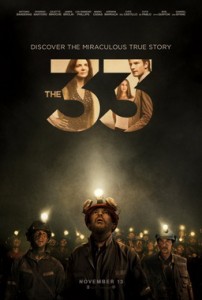The 33
Posted on November 12, 2015 at 5:55 pm

Director Patricia Riggen brings the skill at visual storytelling and tender-hearted but resilient optimism she showed in “Under the Same Moon” to this story. She insisted on filming underground, and the beams of light from the miners’ helmets, so small against the immense darkness of the caverns, are a powerful symbol of the fragility of the miners’ situation. And she opens up the setting just as it becomes unbearable with a poignant fantasy sequence as the starving miners imagine a glorious feast.
We meet the miners at a party and get a sense of who they are — the one who is about to retire, the one who has moved in with his mistress, to the fury of his wife, the one who likes to sing Elvis Presley songs. And we see them go to work, the long, perilous ride, the ominous response of the manager to the complaints of the safety officer. The shards of mirror they lodge in the walls of the mine are shattering, showing that the ground is shifting. “It’s my job to keep them safe,” the supervisor (Lou Diamond Phillips) tells the manager. “It’s your job to keep them pulling out 250 tons a day,” is the reply. “It’s good for another 20 years.” It would not be good for another 20 hours.
Once it has collapsed, the manager refuses to take any action. Either the miners are dead or they will soon be, and there is no way to get them out. The government takes over the mine and sets up operations, with facilities for the families. Soon an entire village is operating outside the mine, including one miner’s pregnant wife, another’s estranged sister (Juliette Binoche), and the feuding wife and mistress. There is a school for the children, a commissary for supplies, a medical facility. They call it Camp Hope.
The first issue is finding out whether there are any survivors. The moment when the note is retrieved, “We are well in the shelter, the 33 of us,” is jubilant. Then there is the challenge of keeping them alive. Food and sleeping bags (and iPods) are sent down and Skype communications are established. But the greatest engineers in the world cannot figure out how to drill down enough of a hole for a rescue without endangering them further. International press has cameras everywhere.
Meanwhile, the stress on the 33 is severe. Who will be their leader? What if they do not agree?
This is a story that was made for the movies and Riggen tells it well. We join the vigil with the families, and the scene of the real miners at the end shows us why the number that really matters is the one that defines them as a group forever.
Parents should know that this film includes dire extended peril and near-starvation, some strong language, and sexual references, some crude, and alcohol abuse.
Family discussion: Was that the best way for the trapped miners to pick a leader? Who should make sure that corporate facilities are safe and what should the penalties be if they are not? Read about the current trial of the former Massey Energy CEO in the US, following a mining accident that killed 29 mine workers.
If you like this, try: the NOVA documentary shown on PBS about the rescue, focusing on the NASA scientists and engineers, and the documentary “Buried Alive”
